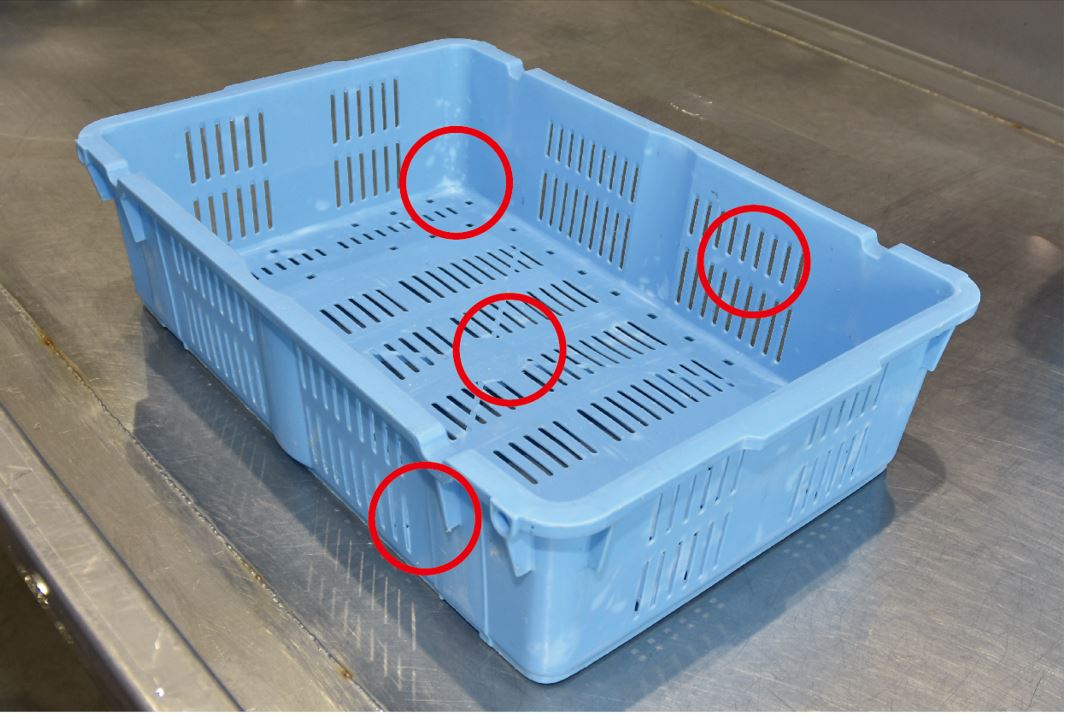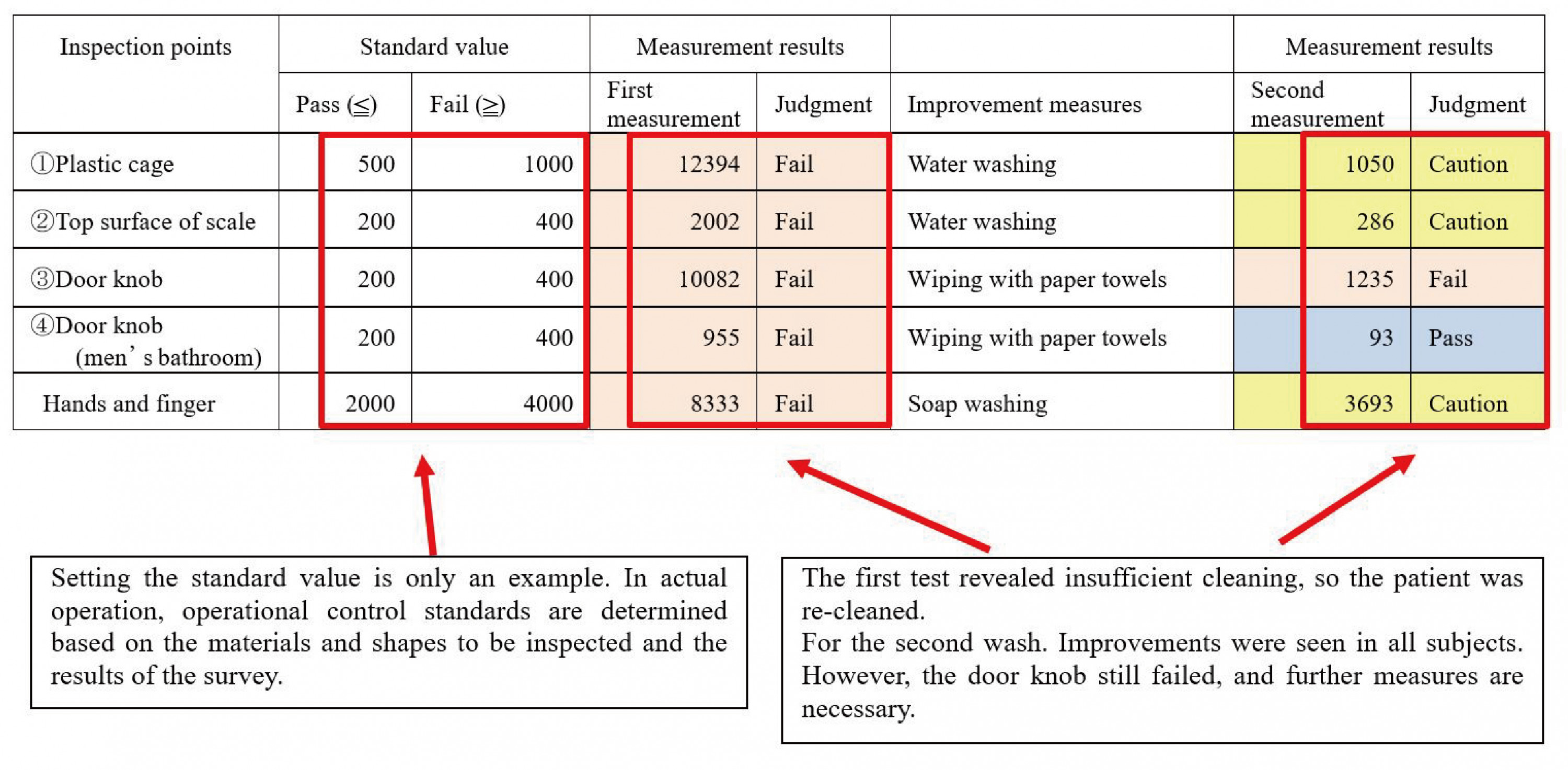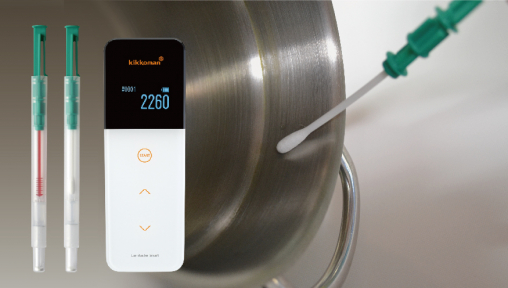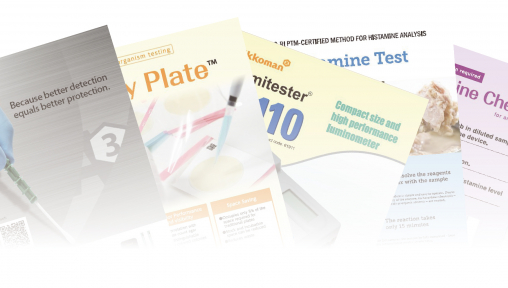1. Đối tượng kiểm tra và thời điểm
Kiểm tra ATP (Kikkoman A3) là phương pháp xác nhận độ sạch của bề mặt. Do đó, các khu vực cần được vệ sinh hàng ngày sẽ là đối tượng kiểm tra.
Hãy thực hiện kiểm tra sau khi vệ sinh khu vực mục tiêu. Những nơi đang làm việc hoặc có vết bẩn rõ ràng sẽ không được kiểm tra vì dễ thấy có nhiều cá và thành phần khác bám vào.
2. Hiểu tình trạng hiện tại và cải thiện phương pháp vệ sinh
Để hiểu tình trạng hiện tại, tiến hành đo sau khi vệ sinh đúng cách đối với đối tượng cần kiểm soát vệ sinh. Nếu có thể, thực hiện nhiều lần kiểm tra trên cùng một đối tượng để xác định khu vực dễ còn sót bẩn sau khi rửa.Ví dụ, với giỏ cá, kiểm tra các phần bên ngoài, bên trong, cạnh và góc dưới để xác định điểm thường bị sót khi rửa (hình minh họa bên dưới).

《Đối tượng đo phù hợp để kiểm soát bằng kiểm tra ATP》
- Các phần tiếp xúc trực tiếp với cá (bàn làm việc, bộ phân loại, hộp cá, thớt, dao, v.v.)
- Khu vực nhiều người chạm vào (ví dụ: tay nắm tủ lạnh, máy tính cá nhân)
- Nơi lưu trữ dụng cụ làm việc, thiết bị chứa, v.v.
- Nhà vệ sinh và khu giặt của cơ sở (vòi nước, bồn rửa, cửa, v.v.)
- Tay và ngón tay của công nhân sau khi rửa tay
3. Thiết lập giá trị tiêu chuẩn
Không thể quản lý vệ sinh nếu tiêu chuẩn đánh giá khác nhau tùy theo ngày kiểm tra và số lượng người kiểm tra. Các điểm kiểm tra được chọn, quy trình lấy mẫu được xác định cho từng đối tượng, và giá trị tiêu chuẩn kiểm soát được thiết lập dựa trên vật liệu, hình dạng và kết quả khảo sát hiện trạng( Xem mục 5. Ví dụ về điểm kiểm tra).
4. Quản lý liên tục
Bằng cách kiểm tra các vấn đề hiện tại, bạn có thể tìm hiểu về cải thiện phương pháp vệ sinh và các điểm quản lý hàng ngày. Tuy nhiên, không thể duy trì môi trường làm việc vệ sinh nếu không có quản lý liên tục. Phần này giới thiệu ví dụ về kiểm tra hiệu quả.
- Quản lý hàng ngày: Thiết lập điểm kiểm soát ưu tiên và thực hiện kiểm tra định kỳ (Xem mục 6. Bảng quản lý kết quả kiểm tra).
- Kiểm tra đột xuất: Thực hiện kiểm tra không theo lịch cho các đối tượng ngoài phạm vi kiểm soát hàng ngày, qua đó nâng cao mức độ vệ sinh toàn bộ môi trường làm việc.
- Giáo dục rửa tay: Thực hiện kiểm tra rửa tay định kỳ để xác nhận việc rửa tay đúng cách, qua đó nâng cao nhận thức vệ sinh của công nhân.
5. Ví dụ về điểm kiểm tra
Điểm kiểm tra ①: Lồng nhựa
Điểm kiểm tra ②: Cân
Điểm kiểm tra ③: Tay nắm cửa
Điểm kiểm tra ④: Tay nắm cửa phòng tắm
6. Bảng quản lý kết quả kiểm tra

Nguồn:
Hiệp hội Kỹ thuật Hệ thống và Tàu cá Nhật Bản. [Quản lý chất lượng và vệ sinh - Bảo vệ giá trị sản phẩm thủy sản tại chợ địa phương] Suisanbutsu no kachi wo mamoru tameno sanchi ichiba no hinshitsu kanri・eisei kanri. 2017.





